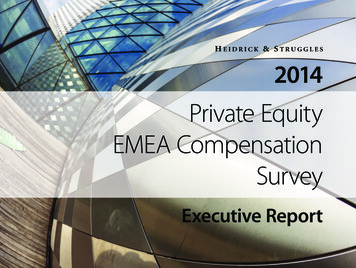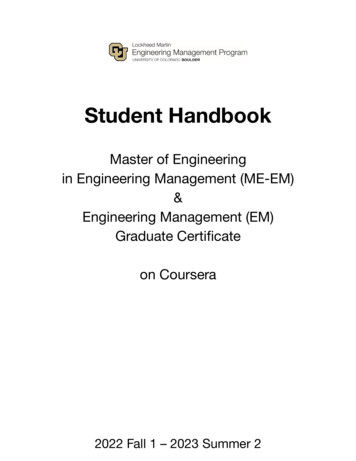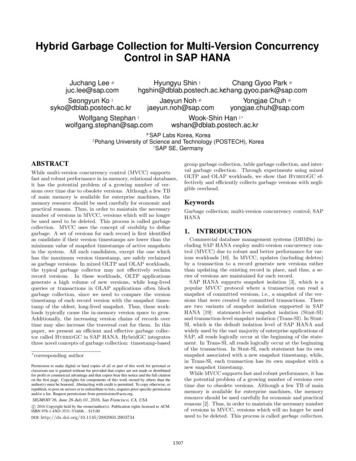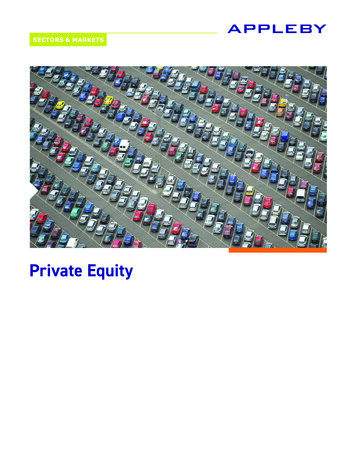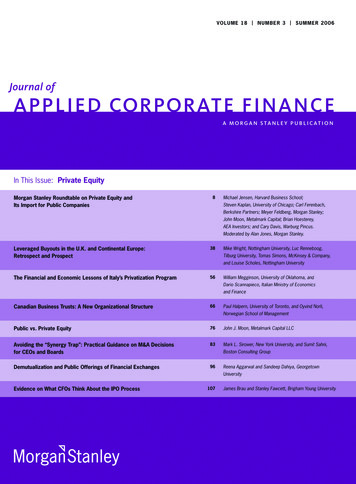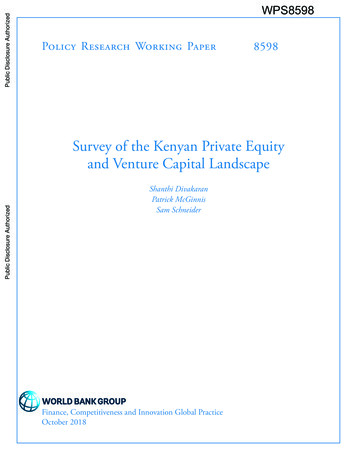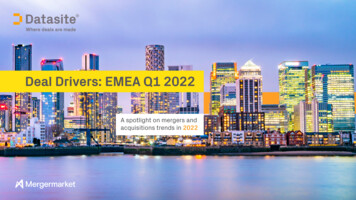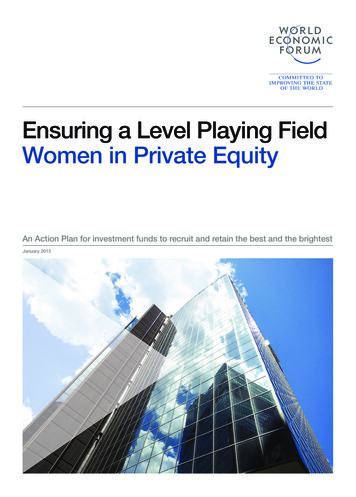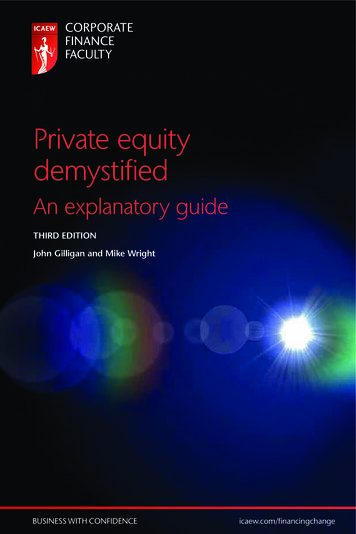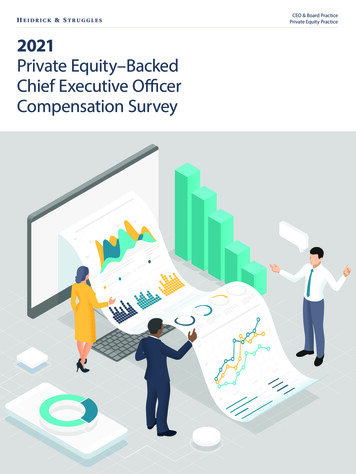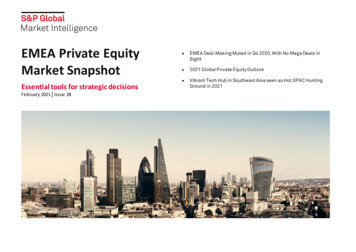
Transcription
EMEA Private EquityMarket SnapshotEssential tools for strategic decisionsFebruary 2021 Issue 28
EMEA Private Equity Market SnapshotEditor’s NoteAuthorsWelcome to the 28th issue of the EMEA Private Equity Market Snapshot (PEMS), aquarterly publication focusing on the Private Equity (PE) market in Europe, theMiddle East and Africa (EMEA) from S&P Global Market Intelligence.Ilja HauerhofElisabeth Bautista SuarezSenior Manager,Product & Market DevelopmentEMEASenior Associate,Investments DataDeal-making in Q4 2020 slowed, with General Partners' (GPs') investments in EMEAseeing a significant drop as a result of a lack of large deals and the Nordics aloneexperiencing growth in deal value. That said, Asia came out strong, winning all highvalue investments of EMEA-based GPs during the fourth quarter.Within the Venture Capital (VC) segment, however, the overall downward trend wasreversed, with VCs seeing a significant increase in capital deployed in the EMEAregion, despite a lower deal count. We explore some of the factors affecting VC dealmaking in detail in our report on our fourth annual survey gauging industrysentiment among PE and VC professionals globally. For a year that has presentedunprecedented market challenges, the optimism leading into 2021 among PE/VCinvestors is striking. While we see fewer exits on the horizon, deal-making activitylooks strong.We close with a feature article on the rise of special purpose acquisitioncompanies (SPACs) in Southeast Asia, which are increasingly being viewed as a morefavorable alternative to the more traditional initial public offering (IPO) route to takecompanies public, particularly among tech-focused startups and unicorns, who areattracted by the flexibility and cost-efficiency of SPACs.We look forward to receiving feedback and suggestions on regions or sectors ofinterest for future analysis. To subscribe or comment on the complimentary EMEAPEMS, please email market.intelligence@spglobal.com.S&P Global Market IntelligenceS&P Global Market IntelligenceRubie Pearl CoralesEwa SkornasAssociate,Product & Market DevelopmentSenior Associate,Investments DataS&P Global Market IntelligenceS&P Global Market IntelligenceAries PoonGaurav RahguvanshiNews Desk Manager and HongKong Bureau ChiefIndustry EditorS&P Global Market IntelligenceRebecca IsjwaraReporterS&P Global Market IntelligenceXiuxi ZhuS&P Global Market IntelligencePriyanka BoghaniAssociate Editor/ReporterS&P Global Market IntelligenceFrancis Ian GarridoReporterAssistant Manager,Worldwide FIG Data JournalismS&P Global Market IntelligenceS&P Global Market IntelligenceIf you would like to read previous issues of this report, please visitwww.spglobal.com/pems-archive2
EMEA Private Equity Market SnapshotEMEA Deal-Making Muted in Q4 2020, With No Mega Deals in SightRelative to the previous quarter, where mega deals aided the growth in aggregate dealvalue, as reported in PEMS Issue 27, deal-making in the fourth quarter of 2020 was slow.Large deals were completed months earlier than usual, compared with 2019, wherethere was a robust pipeline of deals right up to the end of the year, as reported in PEMSIssue 24.Divestment activity in EMEA was stronger than expected during the fourth quarter of2020. Aggregate capital realized increased by 5% year-over-year to 25.2bn in Q4 2020,compared with 24.0bn in Q4 2019. The number of completed exits deals also dropped34% year-over-year, from 317 in Q4 2019 to 236 in Q4 2020. Two exit deals involvingFrench targets notched a 1.0bn valuation during the quarter.Table 1: Completed exit deals in EMEA valued at 1.0bn or more in Q4 2020.Global General Partners’ (GPs’)investments in Europe, the MiddleEast and Africa (EMEA) dropped 67%year-over-year, from 53.6bn in Q42019 to 17.7bn in Q4 2020.However, the number of completeddeals declined only 10% year-overyear, from 1,486 in Q4 2019 to 1,336 in Q4 2020. The lack of large-entry deals (thosevalued at 1.0bn or more) in the fourth quarter of 2020 significantly affected aggregatedeal value. In 2019, there were eight large deals completed, with an aggregate value of 36.0bn.The Nordics were the only region inEMEA that reported a growth in dealvalue, receiving 2.6bn across 132completed deals in Q4 2020,compared with 1.3bn across 123completed deals in Q4 2019. Thesoftness in deal-making during thefourth quarter, however, was mostpronounced in the UK, Rest ofEurope (RoE), and Germany. Aggregate deal value in the UK plummeted 77%, to only 4.7bn across 331 completed deals in Q4 2020, compared with 20.8bn across 301completed deals in Q4 2019. Similarly, RoE targets only received 2.2bn of capital across152 completed deals in Q4 2020, 78% lower than Q4 2019, which saw 9.9bn in capitalreceived across 190 completed deals. Capital deployed in Germany also nosedived to anaggregate of 2.4bn across 167 deals in Q4 2020, compared with 7.7bn across 201deals in Q4 2019. The most heavily impacted sector was Communication Services, whereaggregate deal value was reduced by 89% to a total of 2.1bn across 135 deals,compared with 19.6bn across 153 deals in the comparable quar ter of the previousyear.Source: S&P Global Market Intelligence. For illustrative purposes only.3
EMEA Private Equity Market SnapshotAsia Captured EMEA GP’s AttentionEMEA-based GPs’ aggregate capital deployed globally dropped 46% to total 36.7bn inthe quarter, compared with 67.4bn in Q4 2019. However, the number of completedentry deals only declined 4% year-over-year, from 1,703 to 1,635. Only three large dealswith an aggregate value of 4.4bn, all of which involved Asian targets, were entered byEMEA-based GPs during the fourth quarter, compared with 12 large deals with anaggregate value of 40.9bn in Q4 2019.Table 2: EMEA-based GPs’ completed entry deals valued at 1.0bn or more in Q4 2020Asia won all high-value investments of EMEA-based GPs during the fourth quarter. As aresult, aggregate capital deployed to cross-border targets only declined by 21% yearover-year, from 26.5bn in Q4 2019to 20.9bn in Q4 2020, with thenumber of completed deals rising13% year-over-year, from 368 in Q42019 to 414 in Q4 2020. On the otherhand, investments in EMEA-basedtargets were significantly reduced toonly 15.4bn in the quarter,compared with 40.8bn in Q4 2019.The number of completed deals, however, only declined by 9%, from 1,335 in Q4 2019to 1,211 in Q4 2020.EMEA-based GPs’ aggregate capital realized from divestments more than doubled yearover-year to total 51.8, compared with 18.0bn in Q4 2019, despite the number ofcompleted exit deals decreasing 18% year-over-year, from 321 in Q4 2019 to 262 in Q42020. Eight large exits deals valuedat 41.6 were completed by EMEAbased GPs during the fourth quarter.Deal-making within the venture capital (VC) segment was evidently more fruitful. GlobalVCs deployed 5.6bn of capital in the EMEA region across 784 deals in Q4 2020 – a 44%increase over the 3.9bn in capital deployed across 888 deals in Q4 2019. Financials andHealthcare sectors were the focus of investments among VC firms. EMEA-based VCs alsoincreased capital deployment globally to 9.6bn across 967 deals during the quarter,compared with 6.7bn across 1,022 deals in Q4 2019.Source: S&P Global Market Intelligence. For illustrative purposes only.4
EMEA Private Equity Market SnapshotTable 3: EMEA-based GPs’ completed exits deals involving cross-border targets valuedat 1.0bn or more in Q4 20202021 Global Private Equity OutlookGPs share their perspectives for 2021For the fourth consecutive year, S&P Global Market Intelligence conducted an annualsurvey among PE and VC professionals globally to gauge industry sentiment for theupcoming month. 1 The study covered GPs’ expectations around deal-making,fundraising and exit activity, investment preferences, threats to growth, and approachesto Environmental, Social and Governance (ESG) factors.Bullish PE investors set to focus on new opportunities2020 has been a year like no other and the PE industry has felt the impact. But despiteits challenges, the industry has proven resilient and adaptable to the new workingenvironment.As the pandemic hit the market at the end of Q1 and going into Q2, the PE market sawan abrupt and strong decline in deal-making. Transactions were put on hold while GPsshifted their focus toward stabilizing existing portfolio companies and providingoperational support. As the COVID-19 situation normalized over the summer, PEinvestors turned their attention back to executing deals, leading the industry into astrong rebound in the second half of the year. In fact, Q3 hit a three -year high with totaltransaction volume reaching 168bn, a 90% increase over the same period the yearbefore (Fig. 1). Although deal count fell slightly in Q4 year-over-year, capital deployedwas almost on par over the same period in 2019, bringing the total amount invested inH2 to 320bn. The top performer, Asia-Pacific (APAC), almost doubled the moneyinvested in H2 over the same period in 2019, while North America registered a 30%increase in deal value in the second half year-over-year.2Source: S&P Global Market Intelligence. For illustrative purposes only.5
EMEA Private Equity Market SnapshotSource: S&P Global Market Intelligence. For illustrative purposes only.Source: S&P Global Market Intelligence. For illustrative purposes only.Against the backdrop of the worldwide rollout of vaccination programmes, the new U.S.presidency, and Brexit finally coming to a close, PE investors are demonstrating anoverwhelmingly bullish outlook for the industry. Likely, this relatively optimistic dynamicwill continue over the next 12 months. Despite ongoing economic uncertainty, onaverage, 68% of survey respondents believe investment activity will improve (Fig. 2).APAC investors are the most buoyant among all respondents; three quarters of PEprofessionals from the region anticipate the upward trend of transaction volumes tocontinue. On aggregate, only 7% of those surveyed believe the investment landscapewill deteriorate in the coming months. This is in stark contrast to last year’s survey,where almost 20% of respondents anticipated a worsening investment outlook. WhileEuropean PE players do see investment opportunities arising in the market, with 62%expecting deal-making conditions to improve, they also form the largest group (32%)that believe that investment activity will remain the same. This is a view, however, thatis shared by fewer than a quarter of investors from other regions, underlining the overallsentiment that 2021 will be a year of robust deal-making.In light of this upbeat market expectation, it is not surprising that 56% of surveyrespondents (up from 52% in 2020) intend to target new investment opportunities,while 20% plan to focus on managing existing investments as core investment activities.Realization slumped further from investors’ minds, compared to last year, with PE firmslargely postponing divestment plans. On aggregate, only 6% of respondents anticipateselling part of their holdings in the coming months.With an estimated 1.9 tn 3 in dry powder globally, a low interest rate environment, andpromising new opportunities arising in the market, it is likely that the hunt for goodassets will continue to be very competitive. To better adapt to a prevailing marketenvironment, PE players are increasingly seeking platform acquisition strategies, bothto add value to their existing portfolio companies and to deploy capital more efficiently.More than 40% of PE firms surveyed expect to make both buy & built and add-oninvestments their core investment strategies, with North American and Europeaninvestors leading the way. In addition, minority investments in established businesseshave gained in popularity among PE investors. The number of respondents expecting toimplement a growth capital strategy grew from 36% in 2020 to 52% in 2021, as thehttps://pro.preqin.com/6
EMEA Private Equity Market Snapshotpandemic exposed a great deal of trapped liquidity, as well as a number ofunderperforming private businesses seeking capital injections.In terms of industry focus, unsurprisingly, the two most attractive sectors areInformation Technology (51%) and Healthcare (43%) – two sectors positively impactedby the pandemic (Fig. 3). According to S&P Global Market Intelligence data, PEinvestment in both industries grew by 18% and 23%, respectively, year-over-year.The Consumer sector rounds up the top three most favoured industries of interest. 4However, only 30% of respondents expect to invest in the sector, a drop from the 40%recorded last year – a shift observed across all regions. APAC players appear mostattracted to the sector, with nearly half of respondents planning to invest in 2021. In2020, the total transaction value in the Consumer Discretionary sector, a sub-segmentof the broader consumer sector, stood at 55bn, a decline of 23% compared with 2019.Aware of drastic changes in consumer behaviours, some of which are expected to stay,overall, PE/VC firms appear cautious about investing in certain consumer sectors.Another notable decline in attractiveness was registered by the Industrials sector, withnearly a quarter of respondents planning to invest in the sector in the coming months;however, this is very far from the 41% declaring to do so in the 2020 outlook.When it comes to geographical focus, the vast majority of PE/VC firms (62%) surveyedare planning to concentrate their investments locally, which is a significant increasefrom last year’s outlook (51%). In APAC alone, 75% of capital invested by domestic PE/VCfirms was deployed locally. Investing locally has always been the preferred and logicalapproach for investors, but COVID-19 has imposed limitations on face-to-face businessinteractions at all stages of investments, particularly due to travelling restrictions, thathas made it all the more attractive. PE/VC firms investing locally now have a competitiveadvantage over foreign investors, as they can turn to a more established regionalnetwork for deal origination, negotiating and the management of current portfoliocompanies.Source: S&P Global Market Intelligence. For illustrative purposes only.Fundraising suffers drop but remains resilient in the wake of the pandemicwhile exits stallDespite pandemic-induced challenges, such as travel restrictions, lockdowns andwidespread economic disruption, fundraising activity has remained relatively resilient.In total, 1,502 PE funds held a final close in 2020. Although this number has dropped fora third consecutive year, on aggregate, 628.26bn was raised, which is just a 13% dropfrom 2019 (Fig.4).5 Established firms were able to raise most of the capital, which isperhaps unsurprising given that Limited Partners (LPs) prefer to turn to managers theyhave built relationships with and to firms they are most familiar with.6Going into 2021, around half of the respondents (53%) expect fundraising conditions toimprove, 32% believe it will remain the same, and 15% anticipate fundraising arketintelligence.spglobal.com/web/client?auth inherit&ignoreIDMContext 1#news/article?id 62144282&KeyProductLinkType 237
EMEA Private Equity Market Snapshotto decline, with European and North American investors taking the most cautious viewamong those who responded.strategy (38%), with a likely shift toward domestic stock exchanges – primarily due torising liquidity and valuation, but also on account of growing regulatory uncertaintyabroad.7 While European investors are most likely to exit via trade sale (33%), theirNorth American peers are opting for secondary sale as the top exit strategy, a trendrepresenting shifting industry dynamics.Knock-on effects of pandemic top risk concernAs anticipated, a clear majority of PE/VC firms (61%) identified the “knock-on effects ofCOVID” as the greatest risk factor to the growth of their portfolio, although APACinvestors are marginally less concerned by the effect of COVID-19 compared with theirpeers from other regions (Fig. 5). Changes to the economic environment were rankedas the second biggest risk factor (49%). The third-highest threat varies regionally and istied to localized issues; political upheaval is a major concern in Latin America (4 2%) andMiddle East & Africa (28%), while the high speed of technological change is a concernfor a third of APAC and North American respondents (27%). For 26% of r espondents,shifting consumer preferences are one of the top risks to the stability of portfoliocompanies, up from the 20% of respondents who marked this as a top risk in 2020.Source: Preqin. For illustrative purposes only.Divestment activity has been particularly impacted by the pandemic, dropping by 16%from the previous year to just 2,185 exit transactions, due to pricing uncertainty andmarket volatility in Q2/Q3. On aggregate, almost one third of survey respondents (32%)are not planning exits in the coming year, the highest tally since we launched the annualsurvey four years ago. As investors grapple to understand the full impact of COVID-19on certain sectors, postponing divestments will allow them to take advantage of theexpected growth among the most impacted businesses and to carefully assess marketconditions for a planned exit process. For investors that do consider exiting investmentsin the coming year, there is an apparent regional divergence in terms of preferred exitroutes. APAC players, particularly Chinese PE firms, expect IPOs to be the main exitGoing into 2021, North American and Latin American respondents appear to be lessconcerned about protectionism, with results steeply decreasing from 32% and 33%,respectively, to 19% and 8% over the last year. This could be the result of the revisedNorth American agreement last summer, as well as the new US presidency, both ofwhich are opening up the country again to global organizations. On the contrary, forAPAC investors, protectionism still remains one of the top risks to their assets. Concernover cyber risk has increased this year to 10%, from just 7% the year prior, as more andmore industries are going digital, and workplaces, al.com/web/client?auth inherit&ignoreIDMContext 1#news/article?id 62186813&KeyProductLinkType 248
EMEA Private Equity Market SnapshotStaying for goodESG factors continue to grab PE/VC firms’ attention, with 40% of firms reporting thatthey are planning to work on improving ESG standards within their current portfoliocompanies. The number of firms not considering ESG in the decision-making and postinvestment process decreased from 25% last year to 19% this year, whereas the numberof firms just starting to introduce ESG in their strategy increased from 18% to 24%. Thistrend is particularly evident in North America, which has lagged behind on the ESG frontbut appears to have caught up. The results show a clear shift indicating that many firmsthat had not tackled ESG last year will be working on it this year. ESG was already gainingin momentum but the pandemic amplified and accelerated the need for improved socialwelfare and governance.8 Added to this, regulations are steadily increasing pressure forfirms to get on board. As of March 2021, when the Sustainable Finance DisclosureRegulation comes into effect in Europe, PE/VC firms will be required to report on theirsustainability strategy. Other respondents will either be prioritizing investments withgood ESG track records (29%) or re-evaluating existing ESG diligence (24%). It is clearthat increasing pressure from investors on reporting and action is pushing PE/VC firmsto adapt their ESG strategy,9 even if there is still much to be done on this front.10ConclusionSource: S&P Global Market Intelligence. For illustrative purposes only.As the survey results show, PE/VC investors are optimistic about deal activity and aregearing up to deploy a vast amount of capital that could not be put to work last year.The pandemic has opened an array of opportunities in sectors that have been positivelyimpacted by COVID-19, such as Healthcare Technology, Life Sciences, and InformationTechnology. On top of inorganic growth strategies to enhance the value of their existingportfolio, PE players are increasingly turning their attention to minority investments inresponse to rising numbers of cash-strapped companies in need of liquidity injections.Exits, on the other hand, will be temporarily put on hold, as deal makers try to assessthe long- term impact of COVID-19 on certain industries and set affected businesses ona recovery path. While in the last 12 months ESG has slightly shifted focus fromenvironment to social and governance factors, PE/VC firms have on the eir-Impact-Is-Often-Superficial9
EMEA Private Equity Market Snapshotaccelerated the adoption of ESG methodology into their investment workstreams, nolonger seeing it as a trend, but as an enduring reality.Although this welcomed positive outlook on the industry mainly reflects the vaccinefuelled economic recovery expected in 2021, it also shows how confident PE/VCinvestors have become in navigating the unprecedented challenges of the previous yearand adapting to “the new normal,” boding well for any future storms which may arise.Vibrant Tech Hub in Southeast Asia seen as Hot SPAC Hunting Groundin 2021.Southeast Asia, where the technology startup scene thrives on economic growth and achronic need to boost financial inclusion, is fertile ground for acquisitions for listedblank-check companies in 2021, analysts say.Special purpose acquisition companies (SPACs), which are skeleton organizations thatlaunch with the intention of buying and reverse merging with a private company, havebecome popular alternatives to traditional initial public offe rings (IPOs) to takecompanies public. SPACs from around the world are mostly listed in stock exchanges inthe U.S., where the listing rules require them to acquire private assets from any countrywithin two years after debut. A surge of newly listed SPACs in 2020 suggests that morecompanies are on the hunt for deals before their two-year deadline is up.Indonesia-based tech company Traveloka is also considering a SPAC as possible stockmarket listing option, according to a December 2020 Reuters report. 11 President of theonline travel app, Henry Hendrawan, said the company had been "approached by a few"SPACs.Captured SPAC vs. IPOThe SPAC route is appealing to companies looking for a faster exit and less pre-IPOscrutiny, said Bruce Pang, head of macro and strategy at China Renaissance Securities(Hong Kong)."SPAC might be one of the popular listing options for startups and IPO-ready unicornsin high-growth sectors such as tech, healthcare and fintech, giving a faster, more flexibleand lower-cost way to raise funds with shorter listing timelines than a traditional IPO,"Pang said.Valuation is another factor when a firm decides if SPAC is the way to go forward."In sectors where there are not too many comparable firms or where there's a lot ofuncertainty about valuations, about how big the markets are . those sectors wouldbenefit a lot through listing via SPAC compared with an IPO," said Vidhan Goyal, chairprofessor of finance at the Hong Kong University of Science and Technology."Recently there has been momentum and appetite building in APAC, particularly inSoutheast Asia, where tech-focused startups and unicorns — and their investors — viewSPACs as a more efficient monetization or 'exit' option when compared to conventionalIPOs," said Mark Uhrynuk, corporate and securities partner at Mayer Brown.Experts added that start-ups find it easier to be valued through a SPAC listing versus atraditional IPO because the valuation is determined by private negotiations between thesponsor and the target."While the capital markets in China offer fundraising options to domestic startups there,companies from Southeast Asia, generally speaking, have fewer options. Accordingly,they may be more open to the SPAC alternative for fundraising," he said.Asia is the next hotspotWith quite a few Southeast Asian unicorns — many of which are technology companieslooking to go public — SPAC sponsors have had plenty of target options, experts said.PT. Tokopedia, an e-commerce giant in Indonesia, told S&P Global Market Intelligencethat it is accelerating its listing plans since the pandemic has catalyzed its businessgrowth. It is considering SPAC as "a potential option," having appointed Morgan Stanleyand Citi as advisers. The firm's spokesperson did not provide further details.Asia is looking to see more SPAC activity, both from Asia-headquartered SPACs listing inU.S. or Asian exchanges as well as SPACs acquiring target firms in Asia, or so-called deSPAC-ing, according to Marcia Ellis, global chair of the private equity (PE) group atMorrison & Foerster."The 220 SPACs listed last year [in the U.S.] are looking around for targets. This year isdefinitely the year in which those de-SPAC-ing transactions have to happen. But we are10
EMEA Private Equity Market Snapshotalso seeing more and more SPACs listed with at least 80 SPACs listed in just in January,"she said.December and another US 299mm on Jan. 28. A SoftBank Group Corp.-backed SPACalso closed its IPO on Jan. 13, raising US 603.8mm in proceeds.According to S&P Global Market Intelligence data, Asia-Pacific-headquartered SPACsraised 2.4bn in 2020, a significant increase from 2019's 613mm. That number is on anupward trend in 2021. As of Jan. 31, eight SPACs have already raised 1.71bn.According to S&P Global Market Intelligence data, 19 South Korean SPACs were listed in2020, compared with five from China, four in Hong Kong and two in Singapore.Data as of 02/01/2021. Source: S&P Global Market Intelligence. For illustrative purposes only.Data as of 02/01/2021. Source: S&P Global Market Intelligence. For illustrative purposes only.Although most SPACs are listed in the U.S., many funds that listed those firms are fromAsia and of considerable size.Last year, CITIC Group Corp.'s CITIC Capital Acquisition Corp. floated a US 276mm SPACon the New York Stock Exchange seeking companies in the energy efficiency, cleantechnology and sustainability sectors. Richard Li, son of Hong Kong tycoon Li Ka-shing,has also partnered with billionaire Peter Thiel to establish a US 595mm SPAC in"South Korea is one of the few Asian countries with a framework and regulations aroundSPAC listing and, in fact, the first SPAC IPO in South Korea happened way back in 2010,"said Anish Ailawadi, senior director of investment banking at Acuity KnowledgePartners."So, while Asia is seeing a lot of interest around SPACs, it's a home run for U.S. exchangesgiven lack of established SPAC rules on Asian stock exchanges barring South Korea andMalaysia."11
EMEA Private Equity Market SnapshotMedia & PressData PackIf you are a journalist and would like to contact our communications team,please email: pressinquiries.mi@spglobal.com.S&P Global Market Intelligence’s broad range of solutions and services were usedin the production of this paper. Download a copy of the Data Pack from the S&PGlobal Market Intelligence website. Alternatively, please reach out to marketing atmarket.intelligence@spglobal.com.Product InformationPEMS is a complimentary publication.If you would like to receive future issues direct to your inbox, please subscribe /PEMS-Report-Subscribe-2020.htmlIf you would like to read past issues, please check out our archive:https://www.spglobal.com/pems-archiveFor more information please contact:The AmericasAsia-PacificEurope, Middle East & AfricaE. market.intelligence@spglobal.comP. 1 212 438 8701P. 852 2533 3588P. 44 20 7176 1234W. www.spglobal.com/marketintelligenceP. 1 888 806 554112
EMEA Private Equity Market SnapshotThese materials have been prepared solely for information purposes based upon information generally available to the public and from sources believed t o be reliable. No content (including index data,ratings, credit-related analyses and data, research, model, software or other appl ication or output therefrom) or any part thereof (Content) may be modified, reverse engineered, reproduced ordistributed in any form by any means, or stored in a database or retrieval system, without the prior written permission of S& P Global Market Intelligence or its affiliates (collectively, S&P Global). TheContent shall not be used for any unlawful or unauthorized purposes. S&P Global and any third -party providers, (collectively S&P Global Parties) do not guarantee the accuracy, completeness, timelinessor availability of the Content. S&P Global Parties are not responsible for any errors or omissions, regardless of the cause, for the results obtained from the use of the Content. THE CONTENT ISPROVIDED ON “AS IS” BASIS. S&P GLOBAL PARTIES DISCLAIM ANY AND ALL EXPRESS OR IMPLIED WARRANTIES, INCLUDING, BUT NOT LIMITED TO, ANY WARRANTIES OF MERCHANTABILITY OR FITNESSFOR A PARTICULAR PURPOSE OR USE, FREEDOM FROM BUGS, SOFTWARE ERRORS OR DEFECTS, THAT THE CONTENT’S FUNCTIONING WILL BE UNINTERRUPTED OR THAT THE CONTENT WILL OPERATEWITH ANY SOFTWARE OR HARDWARE CONFIGURATION. In no event shall S&P Global Parties be liable to any party for any direct, ind irect, incidental, exemplary, compensatory, punitive, special orconsequential damages, costs, expenses, legal fees, or losses (including, without limitation, lost income or lost profits and opportunity costs or losses caused by ne gligence) in connection with any use ofthe Content even if advised of the possibility of such damages.S&P
The top performer, Asia-Pacific (APAC), almost doubled the money invested in H2 over the same period in 2019, while North America registered a 30% increase in deal value in the second half year-over-year.2. 6 EMEA Private Equity Market Snapshot . EMEA Private Equity Market Snapshot .
